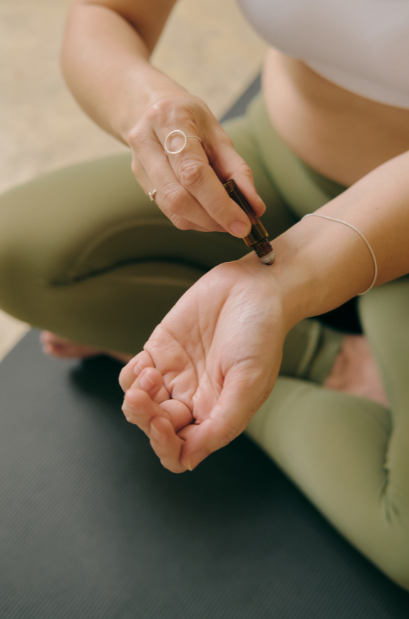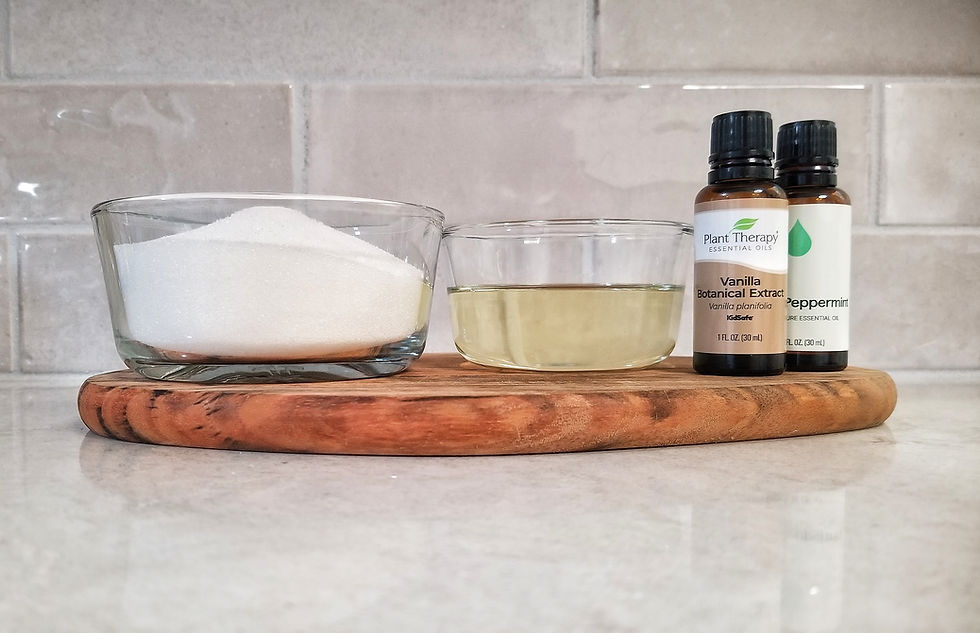Essential Oil Topical Use Applications
- Jean McCabe
- Jul 31
- 5 min read

Guidelines, Benefits, and Best Practices for Safe Skin Application
Essential oils, the highly concentrated extracts derived from plants, have been treasured for centuries for their aromatic, therapeutic, and cosmetic properties. Among the many ways to use essential oils, topical application remains one of the most popular and effective methods. Applied properly, essential oils can support the health of skin, muscles, and joints, as well as provide emotional benefits through their aroma. However, using essential oils on the skin requires knowledge and care to ensure safety and effectiveness.
Understanding Topical Application of Essential Oils
Topical application refers to placing essential oils directly onto the skin after diluting them in a carrier oil. The skin, as the body’s largest organ, absorbs these oils, allowing their active compounds to interact locally or enter the bloodstream for systemic effects (Buckle, 2015; Tisserand & Young, 2014). Typical areas for application include the face, neck, chest, arms, feet, and areas of muscle tension or discomfort. There are rare occasions to use undiluted essential oil, in very small quantities on healthy adult skin, and even then, with caution. (Tisserand & Young, 2014).
Benefits of Topical Use
· Localized Relief: Essential oils can target specific areas, such as sore muscles, bruises, or inflamed joints.
· Skin Health: Many essential oils offer nourishing, soothing, or rejuvenating benefits to the skin.
· Emotional Well-being: The aroma released from the skin during application can help reduce stress and uplift mood.
· Beauty and Cosmetic Enhancement: Certain oils can be incorporated into beauty routines, promoting a healthy complexion and hair.
Dilution
Essential oils are highly concentrated and can cause skin irritation or sensitization if used undiluted. It is standard to dilute essential oils in a carrier oil, such as coconut, jojoba, olive, or sweet almond oil. A typical dilution for adults ranges from 1% to 5%, depending on the oil and the intended use (Tisserand & Young, 2014). For children, pregnant individuals, and the elderly, lower dilutions (0.25%–1%) are recommended.
Practical Blending Chart
10 ml carrier oil:
· 1% dilution = 2 drops
· 2% dilution = 4 drops
· 3% dilution = 6 drops
30 ml (1 oz.) carrier oil:
· 1% dilution = 6 drops
· 2% dilution = 12 drops
· 3% dilution = 18 drops
60 ml (2 oz.) carrier oil:
· 1% dilution = 12 drops
· 2% dilution = 24 drops
· 3% dilution = 36 drops
Common Topical Applications
1. Massage Blends
Essential oils are often added to carrier oils (such as coconut, jojoba, almond, or grapeseed oil) and massaged into the skin. This is effective for muscle relaxation, pain relief, and stress reduction. Standard is using a 1 to 2% dilution rate for a full body massage.
2. Skincare and Facial Treatments
Used in lotions, creams, serums, and masks, essential oils can help balance oily skin, soothe irritation, and support a youthful appearance. Always dilute oils properly due to the delicate nature of facial skin. General dilution rates for facial skin are 0.2 to 1.5%.
3. Spot Treatment
Certain oils, especially tea tree and lavender, are renowned for their ability to address blemishes, insect bites, or minor cuts. Apply a properly diluted solution directly to the affected area. General dilution rates for spot treatments are 2 to 10%.
4. Lotions & Body Oils
Lotions and body oils are a great way to use essential oils to help to lock in moisture and prevent trans epidermal water loss, ensuring that the skin remains soft, supple, and glowing. When essential oils added to lotions and body oils can enhance the moisturizing effects, nourish the skin and add therapeutic benefits. General dilution rates for lotions and body oils are 1 to 3%.
5. Aromatherapy Roll-Ons
These are pre-diluted essential oil blends in a roller bottle, designed for direct application to pulse points, temples, or the neck. They can offer quick stress relief, headache management, energy boost, pain relief, sleep support, or an aromatic perfume. General dilution rates for aromatherapy roll-ons are 3 to 10%.
6. Ointments, Balms, and Salves
They are semi-solid topical preparations, that are made with carrier oils and beeswax. They are used for skin protection, healing, and relief from dryness or irritation. They protect skin, soothe eczema, can support healing minor wounds or burns, and help support pain. Essential oils can enhance these benefits. General dilution rates are 1 to 5%.
Safety Guidelines for Topical Use
While essential oils offer numerous benefits, improper use can lead to adverse reactions. Here are crucial safety tips:
· Always Dilute: Essential oils are highly concentrated.
· Patch Test: Before first-time use of an oil, perform a patch test on a small area of skin to check for allergic reactions or irritation.
· Know Your Oils: Each essential oil has its own maximum topical dilution rate.
Some oils are phototoxic (e.g., citrus oils like bergamot, lemon, lime, and grapefruit) and can cause skin burns or discoloration if exposed to sunlight after application. Avoid sun exposure for 12-24 hours after using these.
· Avoid Sensitive Areas: Do not apply essential oils to eyes, inner ears, mucous membranes, or broken skin.
· Consider Age and Health: Children, pregnant or nursing individuals, those with sensitive skin or certain medical conditions require extra caution. Lower dilution rates and consult a healthcare provider when necessary.
· Storage: Keep oils out of reach of children and store them in dark, cool places to prevent degradation.
Popular Essential Oils and Their Topical Uses
· Lavender: Calming for burns, bites, minor cuts, and stress relief.
· Peppermint: Cooling effect for headaches, muscle pain, and digestive upset (apply to abdomen with carrier oil).
· Tea Tree: Antiseptic properties make it ideal for acne, fungal infections, and bug bites.
· Frankincense: Promotes skin regeneration and reduces scars and inflammation.
· Eucalyptus: Supports respiratory health when applied to the chest and aids muscle recovery.
· Chamomile: Soothes irritated or sensitive skin and can calm inflammation.
· Geranium: Balances oil production in the skin and helps with hormonal breakouts.
· Rosemary: Improves circulation, relieves muscle soreness, and supports scalp health.
Step-by-Step Guide for Safe Topical Application\
1. Choose an essential oil appropriate for your desired benefit.
2. Determine the appropriate dilution based on user age, skin type, and intended use. Do not forget to check the maximum topical dilution rate of your essential oil.
3. Mix the essential oil with your chosen carrier oil in a clean container.
4. Perform a patch test by applying a small amount to the inner forearm. Wait 24 hours to check for reactions.
5. If no irritation occurs, apply the blend to your target area, massaging gently for absorption.
6. Monitor skin for any delayed irritation or sensitivity, discontinuing use if any discomfort occurs.
Frequently Asked Questions
Can I apply essential oils directly to my skin?
In most cases, essential oils should be diluted before skin application. Only a few oils, such as lavender or tea tree, may occasionally be used undiluted and in very small quantities on healthy adult skin, and even then, with caution.
What should I do if I have a skin reaction?
If itching, redness, or burning occurs, stop using the oil immediately. Wash the area with mild soap and water and apply a carrier oil to dilute further. If symptoms persist, seek medical advice.
Are essential oils safe for children and during pregnancy?
Always use lower dilution rates for children and avoid certain oils altogether. Some oils are not recommended during pregnancy and for babies. Consult a qualified healthcare professional before use.
Conclusion
The topical use of essential oils can be a rewarding way to harness their benefits for physical, emotional, and cosmetic health. By understanding the principles of safe application, appropriate dilution, and proper selection, individuals can integrate essential oils into their wellness routines with confidence. As with all natural remedies, education, moderation, and respect for the power of plants are key to enjoying essential oils safely and effectively.
References
Buckle, J. (2015). Clinical Aromatherapy: Essential Oils in Healthcare (3rd ed.). Elsevier.
Tisserand, R., & Young, R. (2014). Essential Oil Safety: A Guide for Health Care Professionals (2nd ed.). Churchill Livingstone.
Tisserand R., 2022, How to Use Essential Oils Safely, Tisserand Institute, https://tisserandinstitute.org/safety-guidelines/




Wonderful saving